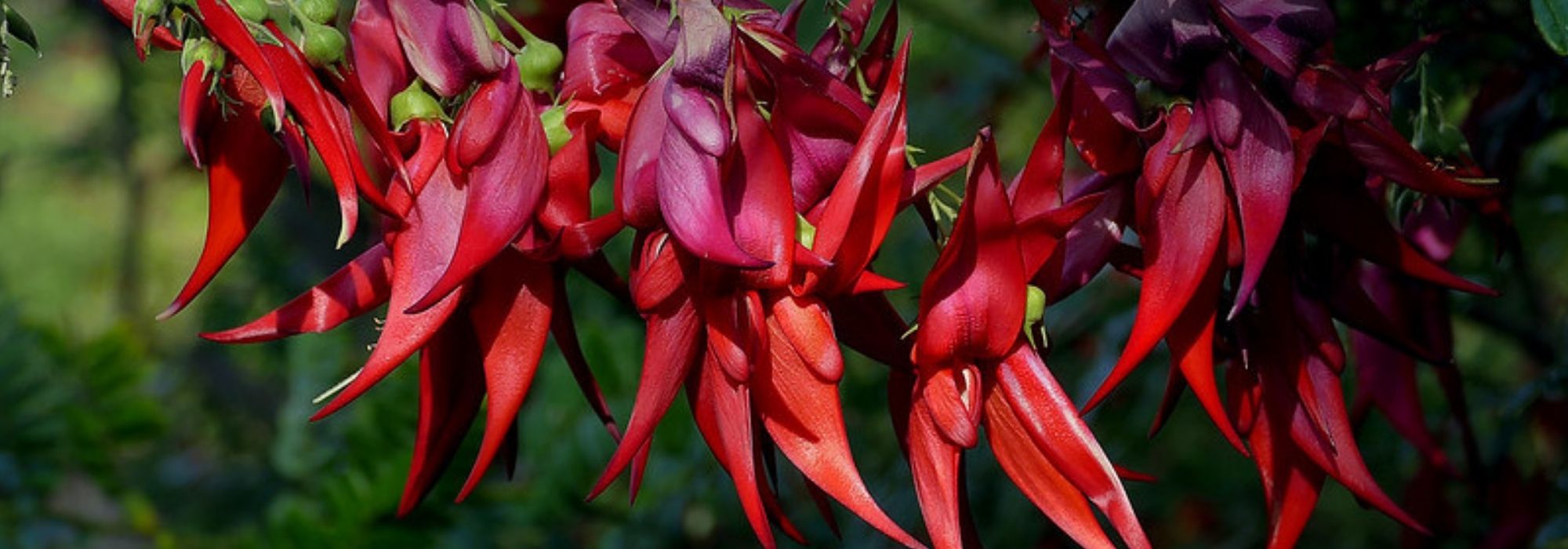
Clianthus puniceus, lobster claw: planting and growing
Contents
The *Clianthus puniceus* in a nutshell
- Clianthus puniceus is a shrub that can be grown as a bush or climbing plant.
- Its flowering is so astonishing that it has earned the nicknames Parrot’s Beak and Lobster Claw.
- The Clianthus thrives in sunny locations in all ordinary soils, remaining cool in summer and well-drained.
- This bush is semi-hardy and best suited to the Atlantic coast or the Mediterranean basin.
- Elsewhere, you can grow a Clianthus in a pot, to be stored frost-free in winter.
The word from our expert
Parrot’s beak, Lobster Claw, and even Kaka beak in its native land! So many amusing names for a plant with such unique flowering: the Clianthus puniceus. The clianthus is a sarmentous shrub (producing long stems) whose astonishing flowering, occurring between March and July, is so peculiar that it resembles either a parrot’s beak or lobster claws. A true botanical curiosity!
Belonging to the Fabaceae family (formerly the legume family), the Lobster Claw has semi-evergreen foliage, divided into numerous leaflets. If left undisturbed, the shrub forms a bush measuring 2 metres in all directions, but its long woody climbing stems can be trained against a wall as an equally original and spectacular climbing plant.
The bush is not fussy to grow in the ground in regions with mild winters (minimum -5°C), such as the Atlantic coast or the Mediterranean basin. It is only necessary to consider a few key requirements of the plant: a not-too-rich soil that remains slightly moist without excess, even in summer, and above all, very well-drained. For the rest, a sunny spot if it is not too hot or, failing that, a place in partial shade, will suit it perfectly.
The Parrot’s Beak can also be grown in pots in other regions with harsher winters. At the first sign of frost, the pot should be moved to a frost-free, cool, and bright location.
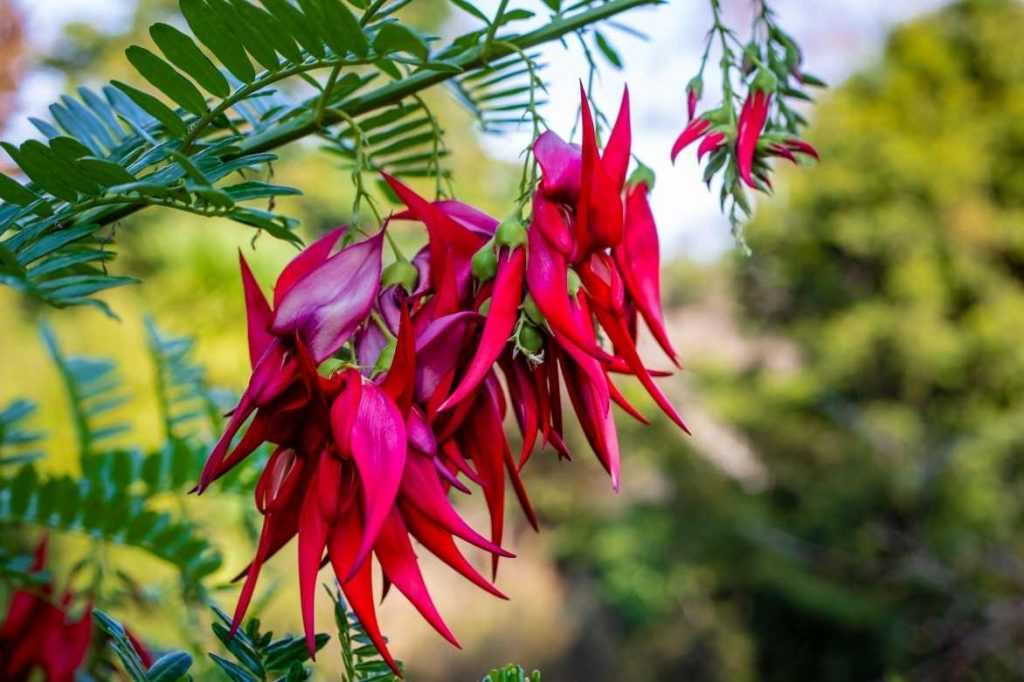
Clianthus puniceus
Botany and description
Botanical data
- Latin name Clianthus puniceus
- Family Fabaceae
- Common name Parrot's Beak, Lobster Claw, Kaka Beak
- Flowering April-July
- Height 2 m
- Sun exposure sun
- Soil type ordinary even poor, but well-drained
- Hardiness -4°C
The Clianthus puniceus, also known as Parrot’s Beak or Lobster Claw, is a shrub native to New Zealand. The genus Clianthus is monotypic, meaning it contains only one species: Clianthus puniceus. Parrot’s Beak belongs to the Fabaceae family, formerly known as the “legume family”. This vast botanical family includes, among others: wisteria, Laburnum, broom, clover, lupin, as well as beans, broad beans, and peas, etc. The distinctive features of this family are the presence of nitrogen-fixing root nodules in the majority of its members (making them valuable in nitrogen-poor soil) and flowers described as papilionaceous. Clianthus puniceus is no exception.
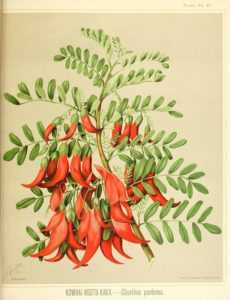
Clianthus puniceus, botanical plate
Although only one species is described, a nuance can be made. Two natural varieties exist: Clianthus puniceus var. puniceus (the stricto sensu species) and Clianthus puniceus var. maximus, with larger and glossier leaves. Some botanists once considered them as two distinct species.
The unique shape of its flowers has earned it the nicknames Lobster Claw or Parrot’s Beak, but it is known as Kaka Beak in its natural range: the cliffs along waterways and forest edges in New Zealand. Understanding its natural habitat helps clarify the shrub’s needs: cool but very well-drained soil.
The Clianthus puniceus is a sarmentous shrub, meaning its stems are long, flexible, and somewhat climbing. Its long sarments can gracefully cascade down a slope, creep along the ground, or be trained against a wall with trellising. Left untrained, the clianthus forms a small bushy shrub about 1.50-2 m tall, but if allowed to climb, it can grow up to 5 m. Growth is relatively slow to moderate in our regions.
The foliage is semi-evergreen, meaning the leaves remain on the plant during mild winters (between 1 and 4°C minimum), otherwise, they fall like deciduous species. The leaves are green with a silky underside and divided into numerous leaflets.
The summer flowering is distinctive. Its long sarmentous stems bear from April onwards clusters of pendulous flowers, curiously shaped with large petals in red, pink, or white depending on the variety, resembling parrot beaks or lobster claws. Flowering typically occurs from April to July, with occasional reblooming in September depending on the climate. These “lobster claws” are actually clusters of large flowers (10 to 15 cm) emerging from the leaf axils and hanging from peduncles. The flowers feature two keeled petals, the “lobster claws” or “parrot beaks”. The flowers give way to green pods that split open at maturity to reveal large black seeds.
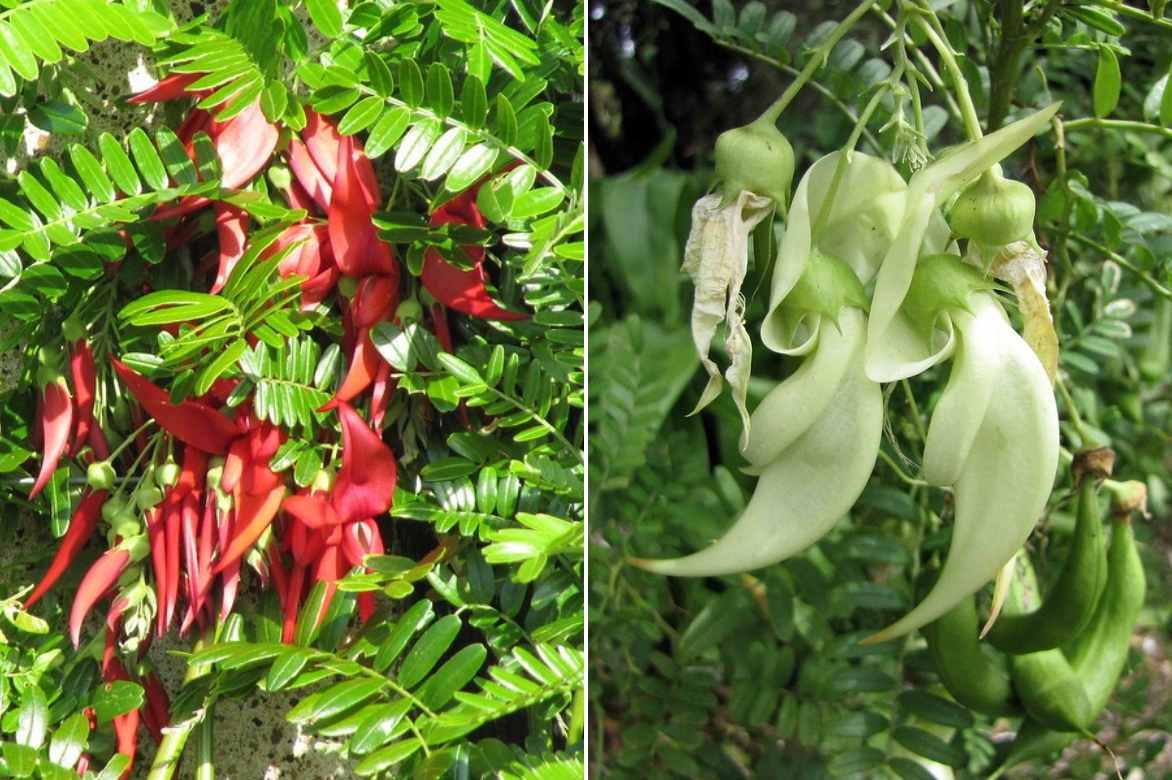
On the left, Clianthus puniceus ‘Kala King’ (© Leonora Enking), and on the right, the ‘Albus’ variety
Please note: In the past, there were two very distinct species in the Clianthus genus: Clianthus dampieri (Dampier’s Clianthus), an Australian annual, and our Clianthus puniceus. Now, the new botanical classification has moved Dampier’s Clianthus to the Swainsona genus: Swainsona pterostylis.
The Clianthus puniceus is listed as “endangered” in its natural habitat by the International Union for Conservation of Nature.
The most beautiful varieties
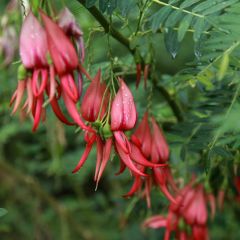
Clianthus puniceus Flamingo
- Flowering time May to August
- Height at maturity 2 m
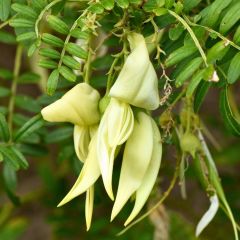
Clianthus puniceus White Heron
- Flowering time May to August
- Height at maturity 2 m
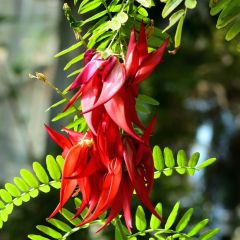
Clianthus puniceus Kaka King
- Flowering time May to August
- Height at maturity 2 m
Discover other Clianthus - Kakabeak
View all →Available in 0 sizes

Available in 1 sizes
Available in 1 sizes
Available in 1 sizes

Available in 1 sizes
Planting the Clianthus puniceus
Where to Plant It?
The Lobster Claw is semi-hardy: this shrub can withstand occasional frosts down to -5°C. Beyond that, the Clianthus will suffer and die. In the ground, the hardiness zone that suits it is 9b, which includes the Mediterranean and the entire Atlantic coast. Outside these areas, Clianthus puniceus can be grown in pots and moved indoors during winter to avoid frost. Also, consider providing it with a location sheltered from cold winds.
The best exposure for it is full sun. However, high temperatures (above 30°C) can cause it distress. If this occurs frequently in your area, try planting it or placing the pot in partial shade.
Regarding the soil, it is not very demanding. Any ordinary soil will do as long as it is not too rich or too dry. The soil should remain cool (slightly moist) during flowering. However, it is essential to ensure the substrate is well-drained. As for the soil pH, the ground should preferably be alkaline or basic.
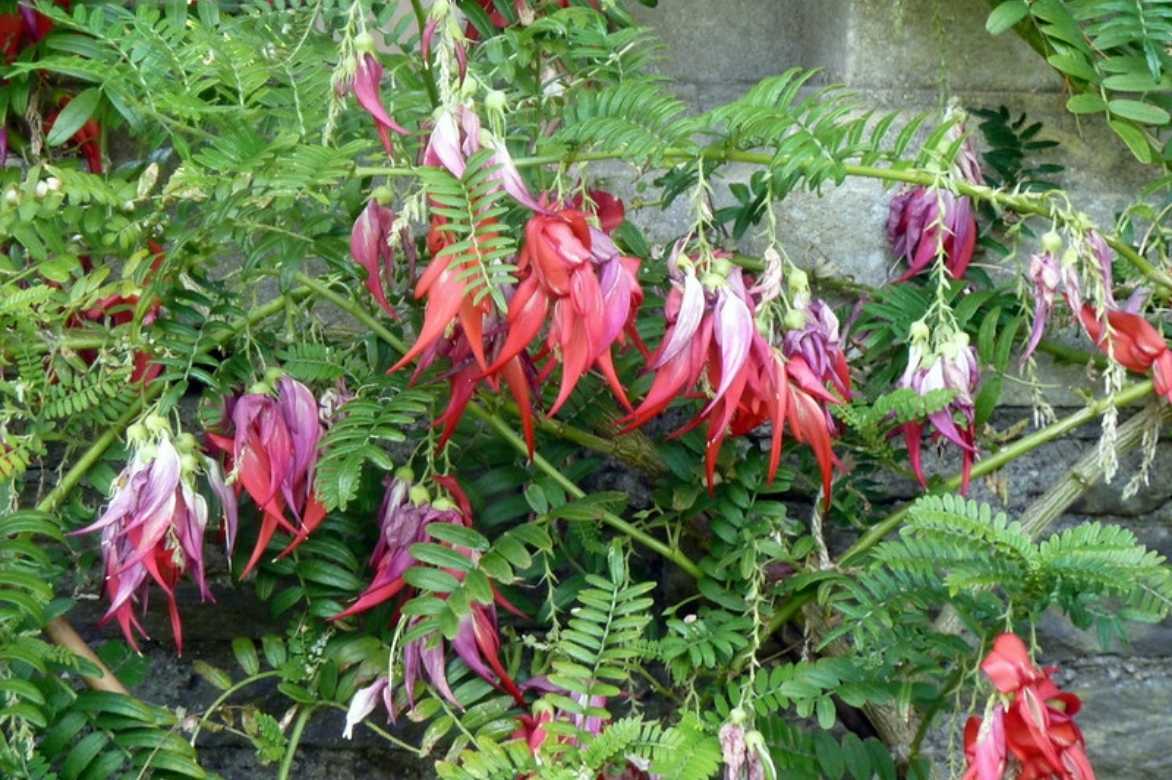
Clianthus puniceus, flowering in May (© Wendy Cutler)
When to Plant It?
Planting is done in spring: between March and April, after the frosts.
How to Plant It?
Allow 2 metres in all directions for each plant. This way, your Clianthus will have enough space to thrive.
In the Ground
- Soak the root ball of your shrub in a basin of water to rehydrate it;
- Dig a planting hole, two to three times the size of the root ball;
- Loosen the bottom of the hole well;
- Remove the Clianthus from its pot and place it in the centre;
- Fill around the plant with the excavated soil, optionally adding some gravel to improve drainage;
- Gently firm the soil around the collar of the plant;
- Water generously to moisten the substrate and avoid “air pockets” between the soil and the roots;
- Guide the shoots towards a support to help them cling if you wish to grow your Lobster Claw against a wall. In colder regions, you can attempt planting in the ground for training against a south-facing wall. However, in areas with hot, dry summers, this situation should be avoided.
In a Pot
- Prepare a mix of horticultural compost, garden soil, and gravel in equal parts;
- Don’t forget to place a layer of gravel or clay pebbles at the bottom of your pot (with drainage holes) to ensure excess water drains away during watering;
- Water regularly throughout the growing season, reducing water intake in winter, ensuring the soil does not dry out completely;
- Bring your plant indoors to protect it from frost at the first sign of cold weather.
Maintenance of the Beak of Parrot
In the Ground
Water if the soil is truly dry deep down, as the Clianthus is sensitive to drought.
Watch out for slugs and snails, which are fond of the young shoots of Clianthus.
At the end of the flowering period (July), carry out a cleaning prune: remove faded flowers and cut back the branches by a third. This operation stimulates regrowth and allows the shrub to become more ramified.
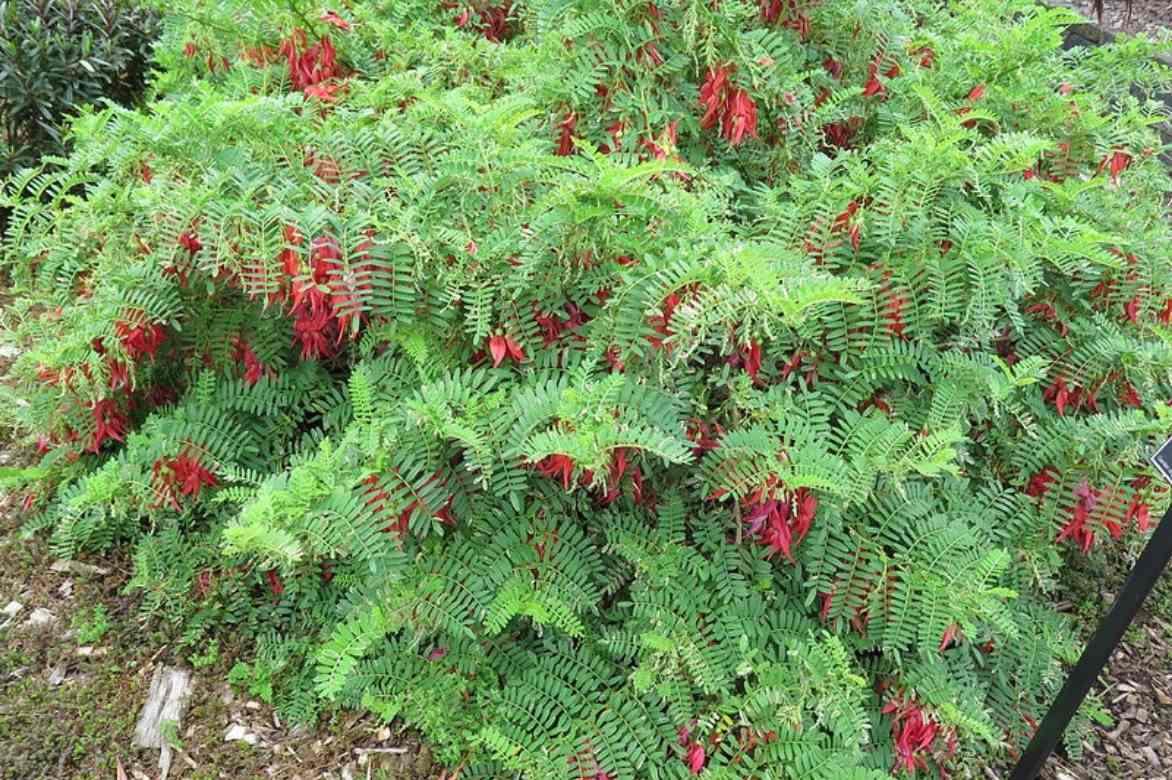
Clianthus puniceus planted in the ground
In a Pot
Provide water regularly: approximately every two days, especially if the weather is dry.
Carry out a cleaning prune after flowering, as mentioned above.
Repotting is only necessary when the roots emerge from the drainage hole, which means the container is becoming too small. This should be done every 2 to 3 years. The roots do not appreciate being disturbed, so repot your Clianthus into a larger pot without disturbing the roots.
Bring the pot indoors at the first sign of frost, placing it in a cool, well-ventilated, and bright location. An unheated conservatory will work perfectly.
Possible diseases and pests
It is important to watch out for slugs and snails in spring when the young shoots and leaves of the bush begin to grow. The “slime producers” are indeed fond of them.
Otherwise, there are no pests or diseases to worry about for the Clianthus if the ideal growing conditions are observed.
The propagation of Clianthus
Propagation is simple by sowing fresh seed in spring, after soaking the seeds in water overnight. The seeds should be placed in well-moistened soil in the light and at a temperature of around 22°C.
Older seeds may germinate after 30 years, but germination results are often disappointing.
How to pair a Lobster Claw plant?
To accompany a Clianthus puniceus, for example, the ‘Flamingo’ variety, it is advisable to choose bushes requiring the same growing conditions: full sun, soil that is not too rich but remains relatively cool, very well-drained, and a mild climate (oceanic climate). If, in addition, the bushes in question flower at the same time and in shades that complement the coral pink of the “lobster claws” of the clianthus, it will be perfect!
We stay on the same continent as the Clianthus with a Boronia heterophylla, a charming Australian bush reaching about 1 m in height, with fine evergreen and aromatic foliage. This bush flowers from May to August in small, pendulous, bright magenta-pink bells, lightly scented. Still in Australia, we discover the Australian mint or Prostanthera rotundifolia ‘Variegata’. The latter flowers in spring with a multitude of small tubular flowers in light purple-pink. The foliage, very aromatic when crushed, is evergreen and olive-green variegated with cream.
Finally, we take a little trip to South Africa with the Grewia occidentalis. This is a vigorous and ramified bush that can reach 1.50 m to 2 m in all directions in the ground. Its glossy green foliage, dentate at the edges, persists more or less depending on the severity of winter. It flowers abundantly in small star-shaped blooms of a slightly mauve pink that open all summer.
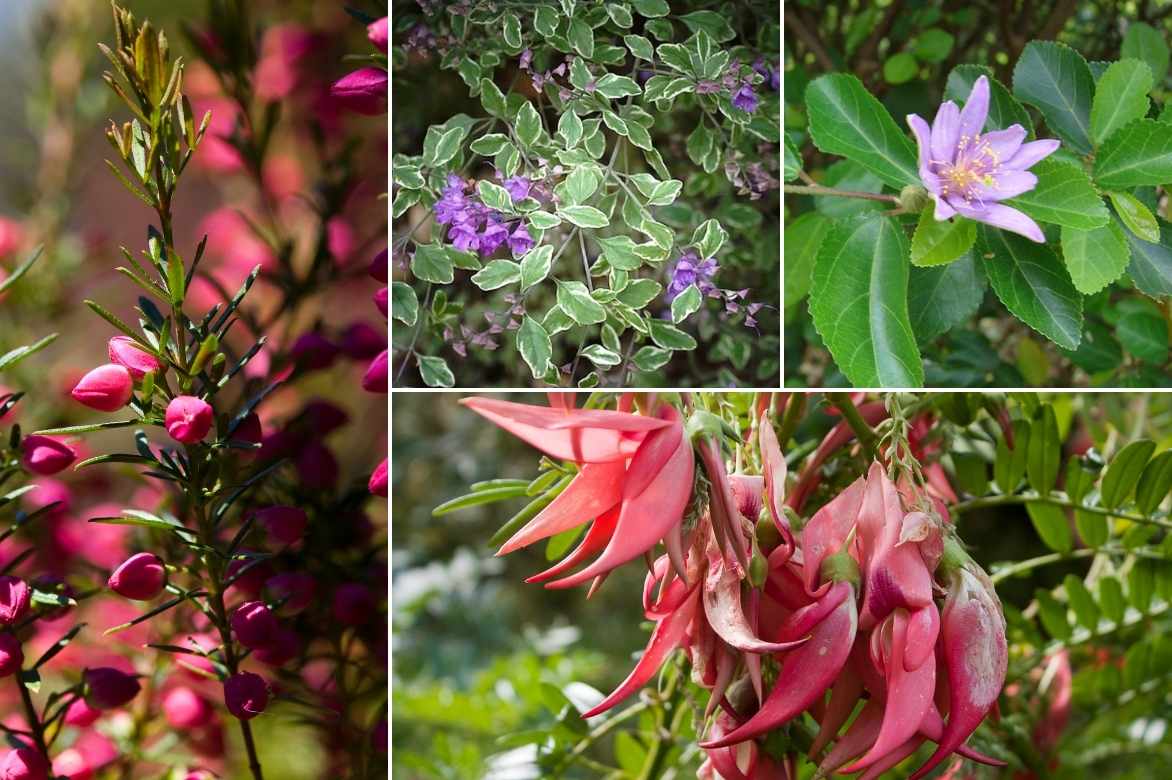
Bottom right, Clianthus puniceus, in association with a Boronia heterophylla, a Prostanthera rotundifolia ‘Variegata’, and a Grewia occidentalis
Useful resources
Discover all our Clianthus puniceus in our online nursery.
- Subscribe!
- Contents































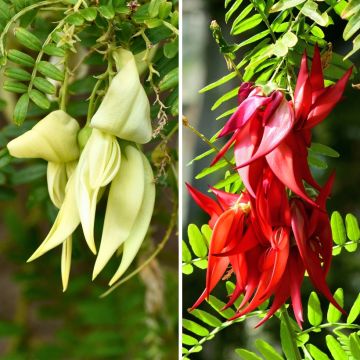

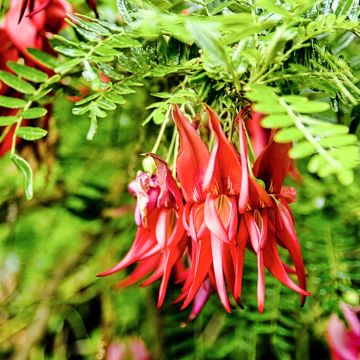
Comments